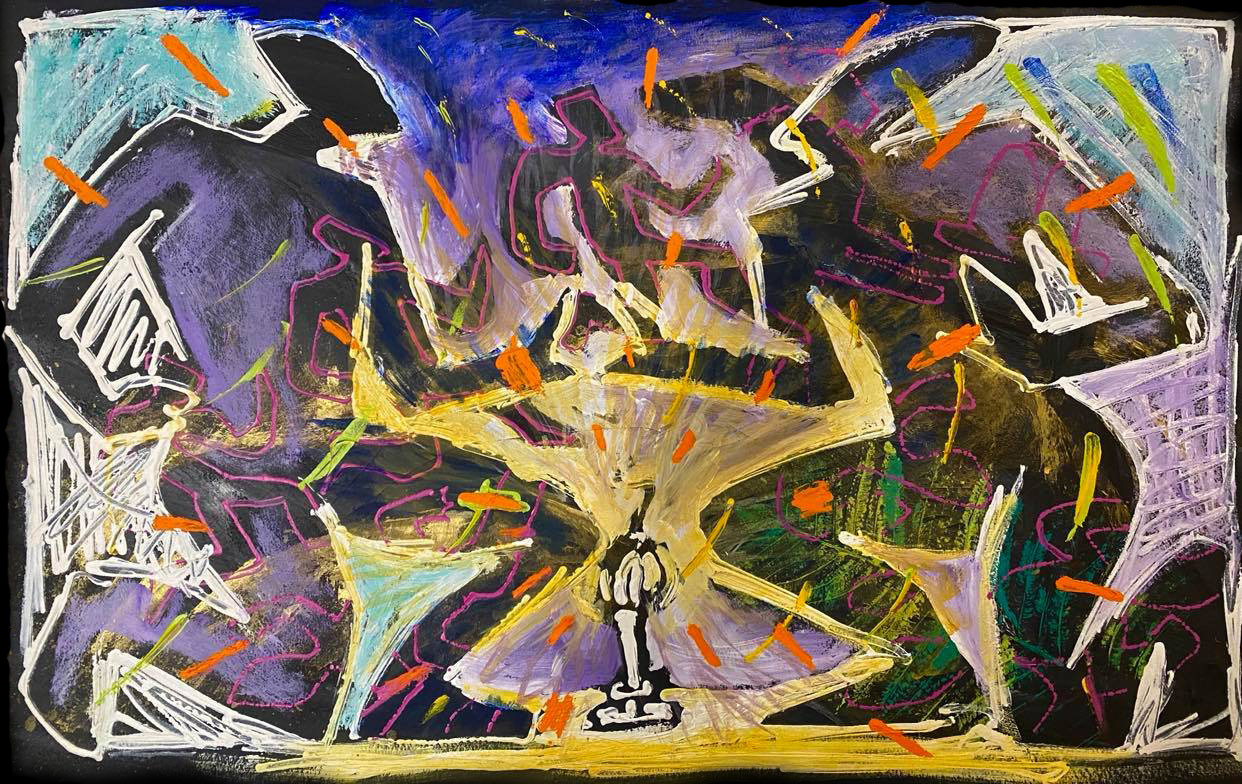Introspection leads to Deeper Relationships.
While this pandemic continues to steal from us the enjoyable social element of our lives, it gives us an unexpected gift. It gives us the gift of a distraction-free opportunity for deep personal introspection and relationship growth.
During the early months of the pandemic, I went from isolated and frustrated to enjoying taking more time to carve wood sculptures in my backyard when it was warm enough and to reading endlessly by the fire when it got cold. I slowed down. Way down. And something started to happen.
For most of my life, I have been driven by an insatiable appetite for exploring the outer world; climbing the highest mountains in Wyoming and Montana, and worming my way into the darkest, dankest caves I could find.
But with my movement now so severely restricted, I have found myself exploring my inner peaks and dark passages from a new vantage point. Now, if you ever decide you want to go spelunking into the depths of your own soul, to visit one of those caverns way back in time where you might then find traces of your own charcoal depictions of woolly mammoths, this is certainly the ideal time to do it.
For such an expedition of introspection, it helps to have a partner who mirrors back to you facets of yourself that lie beyond your conscious awareness. These recondite regions of ourselves seem to lie hidden beneath the sediments of time and lingering sentiments of fear. Yes, a trusted partner is invaluable if you want to bring light to the shadows of your being. A deep romantic relationship seems to be where the hidden inner reefs froth the deceptively calm surface and become glaringly obvious.
My partner is Maria Toso. It was she who first made me aware of the possibility that I might have old experiences that secretly derail me to this day. Naturally, I thought she was wrong. I thought of myself as a straightforward sailor who had successfully navigated his way through the treacherous reefs that had marooned so many.
The outcroppings of disasters were obvious. Still looming over the horizon behind me, my parents’ divorce was surrounded by the riptides of late-night overheard arguments from the top of the stairs where my baby sister and I cowered in the darkness.
There was my repeated failure to catch and hold on to one perfectly thrown pass after another as I ran back and forth across the perimeter of our Scott’s suburban lawn. My dad had been an all-state end. He called me butterfingers. Eh, no biggie.
Tennis was the same. No matter how many lessons I took, I couldn’t develop a consistent serve. And my record as a trout fisherman certainly didn’t merit the investment in equipment. No matter what metric I used, I felt like I was just an average guy in a part of society where average just didn’t cut it.
But Maria was sure I had some buried pains. She called them samskaras. Samskaras are the yogic definition of past experiences of unresolved trauma that lie within like little landmines waiting to detonate when we stumble on them.
She said she could tell by how reactive I would get at certain moments. Like the time when I made her tea and failed to time the steeping—it got “too tannic,” yes, she is from Europe. Because I steeped it too long, she dumped the whole freshly made pot and started over. This left me feeling like, what the hell, I can’t even make tea?!
When Maria insisted we explore why her making a fresh pot of perfectly brewed tea pretty much ruined my mood, I found answers I wasn’t even looking for. She insisted we go lie down so I could feel my body without distraction.
Without doing so overtly, I was shaking my head. I begrudgingly wondered, what does my body have to do with the sinking sensation caused by the Titanic tea? I was in a bad mood—that was all. I figured I should probably go home and get some work done.
But with her usual persuasiveness, Maria guided me to focus into my body where the feeling activated within led me back to that unpleasant sensation of not even being able to catch a football no matter how much my dad coached me.
I simply wasn’t good enough.
Maria’s gentle patience encouraged me to look more carefully—or I should say, feel more carefully—into my body to find the specific spot from which my reactions seem to emanate. Normally, I’d shut the reactor down, diss the insult, and get the hell out of Dodge.
Because in my youth I spent numerous summers working as a cowboy “out west,” and because I live in Minneapolis, west of Saint Paul where Maria lives, Maria and I have a joke about the way I process ego blows. I tell her it’s time to strap on my spurs, saddle up, and head out west.
Over time, I have engaged in this process more willingly with an enhanced awareness of its ability to more accurately source my reactivity. I’ve come to realize that what happens inside me when I am triggered overshadows the immediate event.
What’s amazing about discovering samskaras is that you see how much of what you choose to do is influenced by old, really old, but apparently still viable reactivity. Samskaras are like colored lenses that make you see new experiences in the same light as old ones. So it seems we keep tripping over the same problems, situations, and relationships.
As I have come to understand, you literally cannot move forward, to, for instance, a higher level of awareness, if you are plagued by negative samskaras. And the trick is that discovering them doesn’t get rid of them. But the awareness itself may ease the tension in the knot of your energy.
What will happen to you if you discover a samskara is that, afterward, you will be able to see the pattern in your reactivity to certain situations. This gives you the feeling of having a little more time. Your panic will dissolve and your self-destructive reactions will lessen.
You need to witness yourself. You need to notice when you hate things, when situations or expressions make you mad. Those are signs that you’re facing an energy block. And you can feel these blocks in your body. Such blocks are ingenious inventions of our own consciousness. When we don’t notice them they play a destructive role in our lives, causing us to trip over and over on the same issue or especially the same type of relationship.
How often have you heard a friend say, “I don’t know why I keep falling in love with the same kind of jerk.” The reason is you have some unresolved issues there and you simply cannot progress until you resolve them. So, life keeps presenting you with the opportunity to proceed. And mostly, we keep failing. But we don’t need to.
What we need to do is unravel the knot so that the energy of that particular type of situation can continue to flow freely. The way we do this is first by recognizing the knot and second by accepting and forgiving ourselves for repeatedly failing to untie it.
The more attention you give to these knots, the more free you feel. Frustration begins to fall away. Patience and kindness arise as features of your personality where they never were before. Everything you do begins to be infused with a genuine generosity fueled by your desire to share your new freedom.
I’ve noticed these changes in myself. Maria has shown me how to detect these buried treasures and, as is always the case in a growth relationship, I also inadvertently push her buttons of insecurity or downright fear.
Recognizing the early signs that she is triggered can sometimes, but not always, help me become empathic instead of co-triggered—and vice versa. All this awareness, however, has not prevented us from avoiding all the co-triggered pitfalls. But those pitfalls don’t escalate into the total meltdowns that we experienced in the early years of our now six-year relationship.
Once I became aware of my participation in these meltdowns, I realized I was getting to know myself in a whole new way. Somehow the lack of distractions imposed upon me by social distancing was allowing me to understand what is happening to me when my breath gets tight, and I feel that unwelcome rise of anxiety.
And wanting, like all of us, to feel more free and less frustrated, more gentle and less angry, more forgiving and less accusatory, I have begun to disinter them on my own.
My friend, Steve, recently remarked that he’s noticed some changes in me. I’ve known Steve for about 20 years. We’ve always said we were friends, but mostly we were business acquaintances. I’m an artist. He’s an art patron.
So I thought it unusual that on a recent, brisk Saturday morning he invited me to join him for a walk around one of the lakes in Minneapolis but in spite of the spring snow flurries, we set out at a good pace. We quickly began talking about how we were entering the final quarter of our lives.
“I want to do what you’re doing,” he said. “I want to clean up some of the messes I’ve left behind me. How do you think I would go about that?”
Though surprised by his invitation to a level of emotional intimacy we’d never before experienced, I dove in head-first. I told him about samskaras and the work I was doing with Maria.
“So how do you know if you’ve found one of these samskara things?” he asked.
I told him it would probably show up as a slightly exaggerated reaction to a situation.
“You mean like last night when an attractive woman I didn’t know leaned over at a bar said, ‘We all know you’re bald. So why do you wear that ridiculous hat? It’s such an obvious sign that you’re bald.’ You mean something like that?”
We stopped and stared at each other. He, from under the folded edge of his ridiculous woven hat, and I from beneath the brim of my cowboy-like fedora. It was a wordless moment that felt much longer than it was because it was new to us both.
Finally, I asked, “Where in your body did you feel that, Steve?”
He put his hand on his down-jacketed chest. The moment was raw and without needing to take it any further just yet. So began a new chapter of our friendship.
~

 Share on bsky
Share on bsky






Read 26 comments and reply